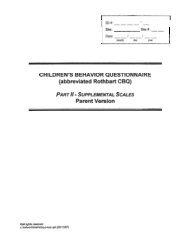A Contextual Investigation of Three-Digit Addition and Subtraction
A Contextual Investigation of Three-Digit Addition and Subtraction
A Contextual Investigation of Three-Digit Addition and Subtraction
You also want an ePaper? Increase the reach of your titles
YUMPU automatically turns print PDFs into web optimized ePapers that Google loves.
146 THE TEACHING AND LEARNING OF ALGORITHMS IN SCHOOL MATHEMATICS<br />
Boxes<br />
Rolls<br />
Pieces<br />
_<br />
4<br />
5<br />
1<br />
3<br />
12<br />
2 7<br />
4 2<br />
8 5<br />
4<br />
Fig. 18.4. Aniquia’s solution on the inventory form <strong>and</strong> the teacher’s graphical<br />
explanation<br />
Rick:<br />
Yeah, ‘cause we’re in the c<strong>and</strong>y factory, not in the usual stuff.<br />
At the end <strong>of</strong> this session, the project team reflected on the students’ discussions<br />
about where to start <strong>and</strong> agreed that it would be beneficial to revisit the issue. We<br />
thought that many <strong>of</strong> the students were making the decision on the basis <strong>of</strong> what they<br />
knew about the st<strong>and</strong>ard algorithm. The students were third graders, <strong>and</strong> they had received<br />
two years <strong>of</strong> traditional instruction <strong>and</strong> had been taught the st<strong>and</strong>ard algorithms<br />
for adding <strong>and</strong> subtracting two-digit numbers. It appeared from the students’ conversations<br />
that they had agreed it did not matter because they were in the c<strong>and</strong>y factory <strong>and</strong><br />
“not in the usual stuff.” We speculated that Cary’s comment about depending on the<br />
kind <strong>of</strong> problem referred to whether or not it was posed in the context <strong>of</strong> the c<strong>and</strong>y<br />
factory. For these students there appeared to be two different “maths”– regular school<br />
mathematics <strong>and</strong> the mathematics they did with<br />
us in the setting <strong>of</strong> the c<strong>and</strong>y factory. They were<br />
therefore able to justify the difference in where Boxes Rolls Pieces<br />
to start because <strong>of</strong> the different norms <strong>and</strong> expectations<br />
in the two instructional situations.<br />
In addition, not only did the students seem to<br />
12<br />
believe that the two “maths” had conflicting<br />
5 2 7<br />
_<br />
norms, but they also appeared to hold different 1 4 2<br />
beliefs about what constituted acceptable explanations<br />
<strong>and</strong> justifications in each situation.<br />
4 8 5<br />
3<br />
Explanations in the c<strong>and</strong>y factory focused on<br />
imagined numerical transactions in the store-<br />
Fig. 18.5. Bob’s solution on the<br />
inventory form






